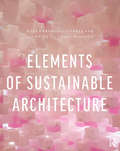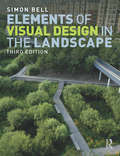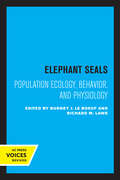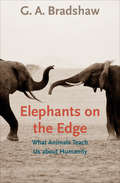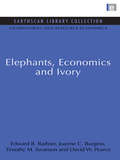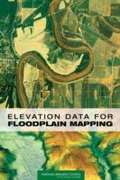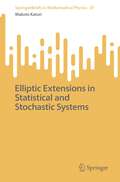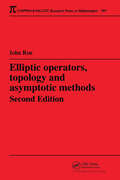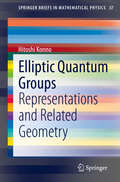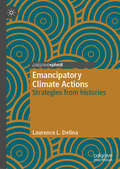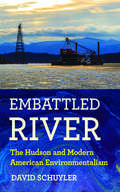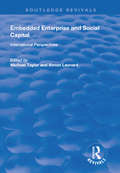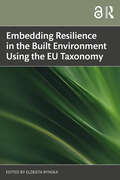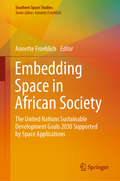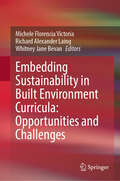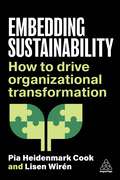- Table View
- List View
Elements of Structural Geology (Routledge Revivals)
by E. Sherbon HillsOriginally published in 1963, this classic textbook was revised fully for the 1972 edition. The author presents a comprehensive account of all topics falling within the domain of structural geology in his characteristically objective, scientific and logical manner. The book pays particular attention to definitions and the origin of terms. Geology is a global science and this book used examples and ideas from work in many countries. The book is comprehensive in scope, dealing not only with secondary structures and tectonics, but also with primary structures of secondary and igneous rocks. This was the first textbook to deal with rock material as two-phase systems rather than as solids and this approach is continued in this reissued edition by analysis of concepts such as ocean-floor spreading and plate tectonics
Elements of Sustainable Architecture
by Rosa Urbano Gutiérrez Laura de la Plaza HidalgoFor sustainable architecture to become a reality, the way we design buildings needs to change. Many architects are concerned that sustainable technologies may interfere with a building’s aesthetic appearance, and so these are often ‘added on’ once the design process is complete. Elements of Sustainable Architecture solves this dilemma by helping students to develop the design skills they need to create sustainable buildings – ensuring that ecological considerations are applied throughout the design process. Restoring the primacy of aesthetics and creativity to sustainable design, the book focuses on strategies that have the greatest impact on building design. It also shows the influence of sustainability considerations on choices about aspects such as composition, form, space, tectonics, materials, colour, textures, proportion and position. Specifically designed to offer a new way of understanding architecture, the book: introduces students to the basic principles and methods of sustainable design; features current examples and inspiring case studies to support learning step by step; presents information in a visually appealing, intuitive, easy-to-understand way; includes over 500 high-quality colour diagrams, drawings, sketches and photographs. A clear, visual introduction to creating aesthetically beautiful and sustainable buildings, this is essential reading for students in sustainable architecture courses.
Elements of Visual Design in the Landscape
by Simon BellWhat makes a visually appealing landscape? How can the design and use of a landscape be harmonized? In this significantly revised and updated third edition of Simon Bell's seminal text, he further explores the answers to these questions by interrogating a range of design principles, applications and ideas. Written for students, instructors and professionals, the book unveils a visual design vocabulary for anyone involved with landscape aesthetics including landscape architects, architects, planners, urban designers, landscape managers, foresters, geographers and ecologists. Structured around key design terms, which are explained and illustrated using an extensive range of examples from around the world, including North America, Europe and Asia, this book enables you to describe, debate and design the visual landscape. It starts with basic elements, before moving onto variable design components, and then the ways these elements are organized into compositions, in order to demonstrate how landscapes are created and how meanings and patterns are perceived within them. This new full colour edition contains over 240 images; an updated introduction; examples from China, Vietnam and central Asia; a chapter on how to read and understand visual design elements in the landscape; a teaching model for instructors; and expanded appendix materials including a glossary, references and further reading.
Elements of a Science Plan for the North Pacific Research Board
by Committee on a Science Plan for the North Pacific Research BoardThe North Pacific Research Board (NPRB) was established in 1997 as custodian to a pool of funds intended for the study of the North Pacific Ocean, Bering Sea, and Arctic Ocean. The success of the NRPB is the development of a high quality, long-range science plan that provides a better understanding of ecosystems and their fisheries in the region. This report provides a framework to help the NPRB identify appropriate science themes and mechanisms for administering and distributing the funds. It contains extensive input from residents of Alaskan communities, to help scientists understand and address issues of importance to the local communities. The book makes specific recommendations on long-term research priorities, the NPRB management structure and the development of future programs.
Elephant Seals: Population Ecology, Behavior, and Physiology
by Burney J. Le Boeuf Richard M. LawsThe largest of all seals, elephant seals rank among the most impressive of marine mammals. They are renowned for their spectacular recovery from near-extinction at the end of the nineteenth century when seal hunters nearly eliminated the entire northern species. No other vertebrate has come so close to extinction and made such a complete recovery. The physiological extremes that elephant seals can tolerate are also remarkable: females fast for a month while lactating, and the largest breeding males fast for over one hundred days during the breeding seasons, at which times both sexes lose forty percent of their body weight. Elephant seals dive constantly during their long foraging migrations, spending more time under water than most whales and diving deeper and longer than any other marine mammal. This first book-length discussion of elephant seals brings together worldwide expertise from scientists who describe and debate recent research, including the history and status of various populations, their life-history tactics, and other findings obtained with the help of modern microcomputer diving instruments attached to free-ranging seals. Essential for all marine mammalogists for its information and its methodological innovations, Elephant Seals will also illuminate current debates about species extinctions and possible means of preventing them. This title is part of UC Press's Voices Revived program, which commemorates University of California Press’s mission to seek out and cultivate the brightest minds and give them voice, reach, and impact. Drawing on a backlist dating to 1893, Voices Revived makes high-quality, peer-reviewed scholarship accessible once again using print-on-demand technology. This title was originally published in 1994.
Elephants
by Seymour SimonJoin award-winning science writer Seymour Simon as he investigates the many characteristics and behaviors of one of the world’s most beloved animals: the elephant! This nonfiction picture book is an excellent choice to share during homeschooling, in particular for children ages 6 to 8. It’s a fun way to learn to read and as a supplement for activity books for children.From their ancient relatives, woolly mammoths and mastodons, to their amazingly versatile trunks and strong ivory tusks, elephants are some of the most fascinating animals on Earth. They are remarkably intelligent, demonstrate self-awareness, and feel familiar emotions like compassion and grief.With clear, simple text and stunning full-color photographs, readers will learn all about the largest land animals in the world!Perfect for young scientists’ school reports, this book includes an author's note, a glossary, and an index and supports the Common Core State Standards.
Elephants on the Edge: What Animals Teach Us about Humanity
by G. A. Bradshaw&“At times sad and at times heartwarming . . . Helps us to understand not only elephants, but all animals, including ourselves&” (Peter Singer, author of Animal Liberation). Drawing on accounts from India to Africa and California to Tennessee, and on research in neuroscience, psychology, and animal behavior, G. A. Bradshaw explores the minds, emotions, and lives of elephants. Wars, starvation, mass culls, poaching, and habitat loss have reduced elephant numbers from more than ten million to a few hundred thousand, leaving orphans bereft of the elders who would normally mentor them. As a consequence, traumatized elephants have become aggressive against people, other animals, and even one another; their behavior is comparable to that of humans who have experienced genocide, other types of violence, and social collapse. By exploring the elephant mind and experience in the wild and in captivity, Bradshaw bears witness to the breakdown of ancient elephant cultures. But, she reminds us, all is not lost. People are working to save elephants by rescuing orphaned infants and rehabilitating adult zoo and circus elephants, using the same principles psychologists apply in treating humans who have survived trauma. Bradshaw urges us to support these and other models of elephant recovery and to solve pressing social and environmental crises affecting all animals—humans included. &“This book opens the door into the soul of the elephant. It will really make you think about our relationship with other animals.&” —Temple Grandin, author of Animals in Translation
Elephants, Economics and Ivory: Elephants, Economics And Ivory (Environmental and Resource Economics Set)
by Edward B. Barbier Joanne C. Burgess Timothy M. Swanson David W. PearceIvory is big business, and in some parts of Africa elephants have been hunted almost to extinction in the quest for it. The losses to African economies have been catastrophic. Now there is an international ban on the trade and conservation is. the principal goal. This should be a matter for rejoicing, but nothing is quite so simple. The authors of this book have looked at the overall statistics, including those for countries where the elephant population is stable. They have considered the multiplicity of economic and social functions fulfilled by ensuring that elephant herds survive, tourism, a variety of ecological purpose. and, finally, as a source of ivory. They show how the careful management of elephants as a resource can best serve African interests. This book is at the cutting edge of economic thinking and provides a model for the consideration of the difficult relationship between people and wildlife. Originally published in 19990
Elephants: Birth, Life, and Death in the World of the Giants
by Hannah Mumby“Walking with these elephants, and with Hannah, will appeal to the Planet Earth viewer and the Robert Macfarlane reader in equal measure.” —Dan Jones, New York Times–bestselling authorWhat Jane Goodall did for chimpanzees, international ecologist and conservation scientist Hannah Mumby now does for elephants in this compelling, eye-opening account that brings into focus this species remarkably similar to humans—and makes a persuasive argument for saving them.These extraordinary animals have so much to teach us, Mumby argues, and Elephants takes readers into their world as never before, revealing a society as complex as the chimpanzees, maybe even humans. Mumby’s exploration of elephant culture provides an empathetic, humanistic portrait of these majestic animals, illuminating their personalities, memories, and rich emotional lives. Mumby explains how elephants communicate with one another and demonstrates the connection between memory and trauma—how it affects individual elephants and their interactions with others in their herd. Elephants and humans, Mumby makes clear, are not very different. From emotional bonding to communication, human and elephant experience similarly nuanced lives, and the commonalities she uncovers are both surprising and heartwarming.Featuring a sixteen-page color insert of original photography, Elephants is a captivating, deeply moving exploration that offers a new way to look at these pachyderms and ourselves and a persuasive, passionate argument for rethinking our approach to animals and their conservation.
Elevation Data For Floodplain Mapping
by National Research Council of the National AcademiesFloodplain maps serve as the basis for determining whether homes or buildings require flood insurance under the National Flood Insurance Program run by the Federal Emergency Management Agency (FEMA). Approximately $650 billion in insured assets are now covered under the program. FEMA is modernizing floodplain maps to better serve the program. However, concerns have been raised as to the adequacy of the “base map” information available to support floodplain map modernization. Elevation Data for Floodplain Mapping shows that there is sufficient two-dimensional “base map imagery” to meet FEMA’s flood map modernization goals, but that the three-dimensional “base elevation data” that are needed to determine whether a building should have flood insurance are not adequate. This book makes recommendations for a new national digital elevation data collection program to redress the inadequacy. Policy makers, property insurance professionals; federal, local, and state governments; and others concerned with natural disaster prevention and preparedness will find this book of interest.
Elite Women and the Agricultural Landscape, 1700–1830 (Studies in Historical Geography)
by Briony McDonaghElite Women and the Agricultural Landscape, 1700–1830 offers a detailed study of elite women’s relationships with landed property, specifically as they were mediated through the lens of their estate management and improvement. This highly original book provides an explicitly feminist historical geography of the eighteenth-century English rural landscape. It addresses important questions about propertied women’s role in English rural communities and in Georgian society more generally, whilst contributing to wider cultural debates about women’s place in the environmental, social and economic history of Britain. It will be of interest to those working in Historical and Cultural Geography, Social, Economic and Cultural History, Women’s Studies, Gender Studies and Landscape Studies. Chapters 2, 3, and 4 of this book are freely available as downloadable Open Access PDFs at http://www.taylorfrancis.com under a Creative Commons Attribution-Non Commercial-No Derivatives (CC-BY-NC-ND) 4.0 license.
Elliptic Extensions in Statistical and Stochastic Systems (SpringerBriefs in Mathematical Physics #47)
by Makoto KatoriHermite's theorem makes it known that there are three levels of mathematical frames in which a simple addition formula is valid. They are rational, q-analogue, and elliptic-analogue. Based on the addition formula and associated mathematical structures, productive studies have been carried out in the process of q-extension of the rational (classical) formulas in enumerative combinatorics, theory of special functions, representation theory, study of integrable systems, and so on. Originating from the paper by Date, Jimbo, Kuniba, Miwa, and Okado on the exactly solvable statistical mechanics models using the theta function identities (1987), the formulas obtained at the q-level are now extended to the elliptic level in many research fields in mathematics and theoretical physics. In the present monograph, the recent progress of the elliptic extensions in the study of statistical and stochastic models in equilibrium and nonequilibrium statistical mechanics and probability theory is shown. At the elliptic level, many special functions are used, including Jacobi's theta functions, Weierstrass elliptic functions, Jacobi's elliptic functions, and others. This monograph is not intended to be a handbook of mathematical formulas of these elliptic functions, however. Thus, use is made only of the theta function of a complex-valued argument and a real-valued nome, which is a simplified version of the four kinds of Jacobi's theta functions. Then, the seven systems of orthogonal theta functions, written using a polynomial of the argument multiplied by a single theta function, or pairs of such functions, can be defined. They were introduced by Rosengren and Schlosser (2006), in association with the seven irreducible reduced affine root systems. Using Rosengren and Schlosser's theta functions, non-colliding Brownian bridges on a one-dimensional torus and an interval are discussed, along with determinantal point processes on a two-dimensional torus. Their scaling limits are argued, and the infinite particle systems are derived. Such limit transitions will be regarded as the mathematical realizations of the thermodynamic or hydrodynamic limits that are central subjects of statistical mechanics.
Elliptic Operators, Topology, and Asymptotic Methods (Chapman & Hall/CRC Research Notes in Mathematics Series)
by John RoeTen years after publication of the popular first edition of this volume, the index theorem continues to stand as a central result of modern mathematics-one of the most important foci for the interaction of topology, geometry, and analysis. Retaining its concise presentation but offering streamlined analyses and expanded coverage of important exampl
Elliptic Quantum Groups: Representations and Related Geometry (SpringerBriefs in Mathematical Physics #37)
by Hitoshi KonnoThis is the first book on elliptic quantum groups, i.e., quantum groups associated to elliptic solutions of the Yang-Baxter equation. Based on research by the author and his collaborators, the book presents a comprehensive survey on the subject including a brief history of formulations and applications, a detailed formulation of the elliptic quantum group in the Drinfeld realization, explicit construction of both finite and infinite-dimensional representations, and a construction of the vertex operators as intertwining operators of these representations. The vertex operators are important objects in representation theory of quantum groups. In this book, they are used to derive the elliptic q-KZ equations and their elliptic hypergeometric integral solutions. In particular, the so-called elliptic weight functions appear in such solutions. The author’s recent study showed that these elliptic weight functions are identified with Okounkov’s elliptic stable envelopes for certain equivariant elliptic cohomology and play an important role to construct geometric representations of elliptic quantum groups. Okounkov’s geometric approach to quantum integrable systems is a rapidly growing topic in mathematical physics related to the Bethe ansatz, the Alday-Gaiotto-Tachikawa correspondence between 4D SUSY gauge theories and the CFT’s, and the Nekrasov-Shatashvili correspondences between quantum integrable systems and quantum cohomology. To invite the reader to such topics is one of the aims of this book.
Elliptic Theory on Singular Manifolds (Differential and Integral Equations and Their Applications)
by Vladimir E. Nazaikinskii Anton Yu. Savin Bert-Wolfgang Schulze Boris Yu. SterninThe analysis and topology of elliptic operators on manifolds with singularities are much more complicated than in the smooth case and require completely new mathematical notions and theories. While there has recently been much progress in the field, many of these results have remained scattered in journals and preprints.Starting from an ele
Elsewhere: A Journey into Our Age of Islands
by Alastair BonnettThere are millions of islands on our planet. New islands are being built at an unprecedented rate, for tourism and territorial ambition. Many are also disappearing, besieged by rising sea levels. The story of our world’s islands is one of the great dramas of our time, and it is playing out around the planet—islands are sprouting or being submerged everywhere from the South China Sea to the Atlantic. Elsewhere is the story of this strange and mesmerizing planetary spectacle. In this book, explorer and geographer Alastair Bonnett takes us on a thought-provoking tour of the world’s most fascinating islands. He traveled the globe to provide a firsthand look at numerous islands, sketching a vivid likeness of each one he visited. From a “crannog,” an ancient artificial island in a Scottish loch, to the militarized artificial islands China is building; from the disappearing islands that remain the home of native Central Americans to the ritzy new islands of Dubai; from Hong Kong to the Isles of Scilly—all have compelling stories to tell. As we journey around the world with Bonnett, he addresses urgent contemporary issues such as climate change, economic inequality and the changing balance of world power as reflected in the fates of islands. Along the way, we also learn about the many ways islands rise and fall, the long and little-known history of human island building and the prospect that the inland hills and valleys will one day be archipelagos. Featuring Bonnett’s charming hand-drawn maps and 33 full-color photos, Elsewhere is a captivating travel book for any armchair adventurer.
Elusive State of Jefferson: A Journey through the 51st State
by Peter LauferBy 1941, a nascent statehood movement began to coalesce into an active and explicit secession campaign seeking to carve from Northern California and Southern Oregon a new State of Jefferson. Yreka, California, home of the secession movement, was named the temporary state capital. Local proponents, Members of the State of Jefferson Citizens Committee, began to stop traffic along Highway 99 at armed roadblocks to pass out political broadsides – their Proclamation of Independence. And, in December of that year, Judge John Childs of Crescent City, California, was elected the first Governor of the State of Jefferson.The United States&’ entry into World War II just days later interrupted this growing movement. News of the bombing of Pearl Harbor replaced the planned coverage of Child&’s election and overshadowed Jeffersonians perceived marginalization with a national sense of unity. But today what often is referred to as the mythical State of Jefferson remains as both an emblem of the north counties&’ frustrations and as a cultural signifier that differentiates the region from the rest of California and the nation.Through interviews with residents and travels through the region, Laufer reveals the story of what could have been and the identity of the region that remains even more than sixty years after the apex of the movement.
Emancipatory Climate Actions: Strategies from histories
by Laurence L. DelinaThis book calls for a collective strengthening of the progressive dimension of climate action in the face of continued myopic governmental response. Delina argues that consent must be revoked and power realigned to avoid suffering the consequences of unabated climate change. He looks back at the mechanisms that make previous social mobilizations successful to design strategies that would advance a new hegemonic agenda. This new agenda calls for the culturing of contemporary human societies towards a hegemony characterized by just emancipations and sustainable transformations. Mining select histories from India, the United States, the Philippines, and Burma, the book explores topics including visioning and identity building; framing; triggering pressure; boosting publicity; and diversifying networks as strategic tools to the repertoires of climate action groups, organizations, and institutions. It will be of great value to academics and practitioners, as well as to anyone interested in how to actively combat climate change.
Embattled River: The Hudson and Modern American Environmentalism
by David SchuylerIn Embattled River, David Schuyler describes the efforts to reverse the pollution and bleak future of the Hudson River that became evident in the 1950s. Through his investigative narrative, Schuyler uncovers the critical role of this iconic American waterway in the emergence of modern environmentalism in the United States.Writing fifty-five years after Consolidated Edison announced plans to construct a pumped storage power plant at Storm King Mountain, Schuyler recounts how a loose coalition of activists took on corporate capitalism and defended the river. As Schuyler shows, the environmental victories on the Hudson had broad impact. In the state at the heart of the story, the immediate result was the creation in 1970 of the New York State Department of Environmental Conservation to monitor, investigate, and litigate cases of pollution. At the national level, the environmental ferment in the Hudson Valley that Schuyler so richly describes contributed directly to the creation of the Environmental Protection Agency in 1970, the passage of the Clean Water Act in 1972, and the creation of the Superfund in 1980 to fund the cleanup of toxic-dumping sites.With these legal and regulatory means, the contest between environmental advocates and corporate power has continued well into the twenty-first century. Indeed, as Embattled River shows, the past is prologue. The struggle to control the uses and maintain the ecological health of the Hudson River persists and the stories of the pioneering advocates told by Schuyler provide lessons, reminders, and inspiration for today's activists.
Embedded Enterprise and Social Capital: International Perspectives (Routledge Revivals)
by Simon LeonardThis title was first published in 2002. The concept of embeddedness refers to the social construction of inter-firm relationships and the enmeshing of economic relationships within broader social structures and relationships in particular places. Previous research has suggested embedding is the best way to generate local growth and social capital and has focused on SMEs in Europe and North America, although the existing model is being more widely adopted now. This volume is the first to examine the complex processes of embedding in this wider context. Bringing together a broad range of case studies from the developed and developing world which address the nature of embeddedness from various perspectives, it not only questions the universality of the current model and the policy initiatives it has spawned but also provides a much wider understanding of embeddedness . It does so by discussing the social dimensions more fully and by throwing light on the spatial and temporal ambiguity of the concept and its inadequate treatment of power.
Embedded Random Matrix Ensembles in Quantum Physics
by V.K.B. KotaAlthough used with increasing frequency in many branches of physics, random matrix ensembles are not always sufficiently specific to account for important features of the physical system at hand. One refinement which retains the basic stochastic approach but allows for such features consists in the use of embedded ensembles. The present text is an exhaustive introduction to and survey of this important field. Starting with an easy-to-read introduction to general random matrix theory, the text then develops the necessary concepts from the beginning, accompanying the reader to the frontiers of present-day research. With some notable exceptions, to date these ensembles have primarily been applied in nuclear spectroscopy. A characteristic example is the use of a random two-body interaction in the framework of the nuclear shell model. Yet, topics in atomic physics, mesoscopic physics, quantum information science and statistical mechanics of isolated finite quantum systems can also be addressed using these ensembles. This book addresses graduate students and researchers with an interest in applications of random matrix theory to the modeling of more complex physical systems and interactions, with applications such as statistical spectroscopy in mind.
Embedding Resilience in the Built Environment Using the EU Taxonomy
by Elzbieta RynskaTaxonomy is the common name for an EU regulation that supports companies in sustainable environmental and climate action (Regulation [EU] No. 2020/852). It is a classification tool designed for investors, companies, and financial institutions to define the environmental impact of business activities and the requirements that organisations must meet to be considered as sustainable.The aim of this book is to examine the EU taxonomy from the built environment perspective and the ways in which it can be used to build resilience in real estate. It presents the issues, hot points, and possible choices from the designers, construction consultants, and investing bodies' points of view, those who must set forth initial conditions, which should later become the keystones for greener developments. It brings together the expertise of a unique team of both researchers and professionals and presents a methodology, case studies, and solutions which together comprise a novel understanding of the taxonomy’s influence on the pre-construction phase. The book:• describes the role of the built environment within sustainable development and how real estate can be used to build resilience with the use of taxonomy.• describes the characteristics of resilient environmentally friendly cities in the future.• proposes a roadmap to demonstrate urban policies that promote decarbonisation; and•enables investors to compare their products, operations, and strategies in terms of sustainability.Overall, this book is essential reading for decision-makers in the public and private sectors, urban developers, space and spatial designers, architects, planners, community stakeholders, and real estate investors.Chapter 1 of this book is freely available as a downloadable Open Access PDF at http://www.taylorfrancis.com under a Creative Commons Attribution-Non Commercial-No Derivatives (CC-BY-NC-ND) 4.0 license.
Embedding Space in African Society: The United Nations Sustainable Development Goals 2030 Supported by Space Applications (Southern Space Studies)
by Annette FroehlichThis book provides a detailed insight into how space and its applications are embedded, and can be further embedded, into African society in support of the SDGs, while taking into account the specific features, needs, and diversity of that society.Contributions drawn from across the continent and further afield provide analyses of the particular social situations in a variety of different African countries and regions, and highlight areas where space applications support the SDGs, and where they can further do so. The chapters cover a wide array of relevant and timely topics including basic needs like water quality, education, and capacity building, as well as financial, security, and legal aspects, together with facets of space technologies and infrastructure in Africa. Embedding Space in African Society will be of great interest to students and professionals in sustainable development, governance, and space studies.
Embedding Sustainability in Built Environment Curricula: Opportunities and Challenges
by Michele Florencia Victoria Richard Alexander Laing Whitney Jane BevanThis book offers a comprehensive collection of best practices, gathered from classrooms across the globe, aimed at actively engaging students in sustainability. These tried and tested methods, presented within its pages, provide educators with valuable tools that can be easily adopted or tailored to their own academic environments. Moreover, this book serves as resource for policymakers, shedding light on the fundamental drivers and formidable challenges associated with integrating sustainability principles within higher education institutions. As an added bonus, researchers will find an overview of the cutting-edge literature currently available, as well as valuable suggestions for future research.
Embedding Sustainability: How to Drive Organizational Transformation
by Pia Heidenmark Cook Lisen WirénEmbedding Sustainability is a practical, solutions-focused guide for sustainability managers and leaders to embed sustainability in organizations and drive improved performance.For organizations to truly embody sustainability, it must infuse all operations. Sustainability change agents need to be the conductors of the orchestra, making sure everyone has the same objective, is working with the same goals and is moving at the same pace. Embedding Sustainability charts the journey from purpose, scope and assessment to strategy, implementation and integration. It outlines the steps required to engage and commit employees to deliver to the same goals, creating a workplace where success is achieved through collective effort.Drawing on impressive experience, the authors share valuable tools and tips, lessons and coaching, factoring in different organizational maturity levels, international contexts and cultural differences and stakeholder mapping.It explores leadership principles, values, culture, strategies and engagement methods. Embedding Sustainability provides mid-senior sustainability professionals with guidance and encouragement to continue with their work and avoid common mistakes, while also prioritizing their own wellbeing. It will help sustainability change agents navigate the unique challenges of this role, find solutions to problems and maintain a positive outlook.

